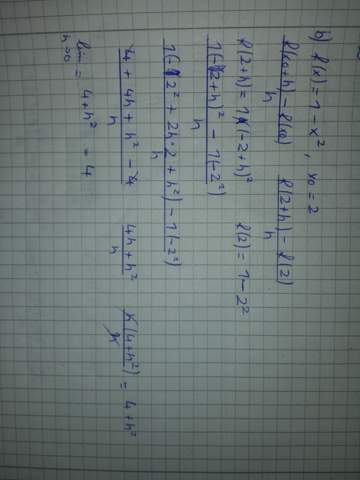Mathematik h-Methode Aufgabe?
Hallo, ich muss folgende Aufgabe lösen bis morgen für die Schule, jedoch bin ich mir nicht sicher, ob ich das so richtig habe. Könnte vielleicht jemand mal drüber schauen?
Aufgabe: Berechnen Sie die lokale Änderungsrate von f an der Stelle x0 mit Hilfe einer exakten Grenzwertrechnung.

Soll jetzt nicht falsch rüber kommen. Möchte nur wissen, ob ich das richtig verstanden habe. Dankeschön!
2 Antworten

f(x)=1-x² abgeleitet f´(x)=-2*x siehe Mathe-Formelbuch,Differentationsregeln,elementare Ableitungen
Differenzenquotient m=(y2-y1)/(x2-x1) mit x2>x1 x2-x1=h
m=(f(x+h)-f(x))/h
m=(1-(x+h)²)-(1-x²))/*1/h
binomische Formel (x+b)²=x²+2*b*x+b²
(x+h)²=x²+2*h*x+h²
m=(1-(x²+2*h*x+h²)-(1-x²))/h=(1-x²-2*h*x-h²-1+x²)/h=-2*h*x-h²/h
m=-2*x-h
lim (-2*x-h) mit h→0
y´f´(x)=-2*x mit xo=2
y´=f´(2)=-2*2=-4
Hinweis: f(x)=1-x²=1*x⁰-x²
f´(x)=1*0*x^(0-1)-1*2*x^(2-1)=0-2*x¹=-2*x
Potenzregel (x^k)´=k*x^(k-1)
Summenregel f´(x)=f´1(x)+/-f´2(x)+/-....f´n(x)
f(x)=f1(x)-f2(x)=1*x⁰-1*x²

Wo kommt das -2 in Zeile 3 her?
f(2 + h) = 1 - (2 + h)²